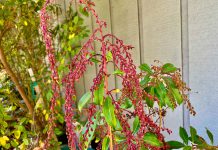More Walking Space Needed on Highway 9 in Felton
The Highway 9 Complete Streets Study led by the Santa Cruz Regional Transportation Commission (RTC) was a 2-year effort costing in excess of $250,000. Throughout the document, State Highway 9 (operated by Caltrans) is referred to as the “Main Street” of the town centers and that a greater focus on pedestrian safety is needed throughout the corridor. Across the nation, a widely used low-cost improvement to improve walking and cycling safety and to slow traffic is lane narrowing where it is safe to do so.
Caltrans’ Design Manual states: “For conventional State highways with posted speeds less than or equal to 40 miles per hour and AADTT (truck volume) less than 250 per lane that are in urban, city or town centers (rural main streets), the minimum lane width shall be 11 feet. The preferred lane width is 12 feet.”
The section of Highway 9 just north of the traffic signal in Felton was cited as needing more walking space for students and residents near the retaining walls on the west side. One low cost option noted was lane narrowing from 12’ to 11’, but Caltrans officials in San Luis Obispo have informed the RTC that total truck counts are “estimated” at 900 per day, thus a design exception would be required. But Highway 9 is three lanes in this section, resulting in 450 trucks in the northbound (NB) lane and 225 trucks in each of the two southbound (SB) lanes.
In my view, a quick and affordable solution for pedestrian safety is to widen all the stripes from 4” to the new standard of 6”, keep the NB lane at 12’ and narrow each SB lane to 11’ as stated in the design manual. This would provide 2 more precious feet of walking space near the retaining walls.
James Helmer, P.E. , Ben Lomond
BLM Article Response
Two months ago there was a long article written by Scotts Valley students about color, police, and “systemic racism”. It’s unfortunate that police really aren’t in a position to respond due to the fact that they are under the command of political leaders. So I’d like to present something in the interest of balance.
Everyone has heard of George Floyd. The media has played the video of his death thousands of hours on television. Everyone in the world has seen it. Watching the video presents a negative image of the police. In fairness though how many have heard of Officer Johnathan Shoop? On July 13, 2020 he made a routine traffic stop in Bothell, Washington. This officer was white and the driver of the Pontiac he stopped was black. The driver, 37-year-old Henry E. Washington drove away, the hit a pedestrian on a scooter in a crosswalk, barreled through the center median and then stopped. According to video footage and witnesses, the driver exited the Pontiac and walked towards the police SUV while firing a handgun at it. He then ran from the scene as the police SUV continued forward, glanced off the Pontiac and rolled several hundred yards before coming to a stop against a tree.”
Assisting officers arrived on the scene to find both officers in the SUV had been shot, with Officer Shoop in the driver’s seat. He was pronounced dead at the scene. The suspect was apprehended, taken to King County jail at approximately 3:04 AM and booked into jail on Investigation of Homicide, Felony Assault, and Vehicular Assault. A white cop is murdered by a black suspect and the main stream media is silent. The media is spinning the narrative if they don’t give equal television time to police killed in the line of duty.
Press Banner Response to Mr. Duffy
Thank you for being a reader of our paper, and for taking the time to share your thoughts.
The story of George Floyd’s death was compelling for several reasons. For all the murders that happen across our country, both by and of police officers, very few of them are recorded. That the nation, and the world, were able to watch Floyd’s murder at the hands of Minneapolis police officers was jarring. That Floyd’s life slowly drained out of his body over eight minutes and 43 seconds as he lay pinned beneath the knee of Officer Derek Chauvin while other officers made no attempt to intervene was harrowing. That the lack of humanity displayed in his killing was an incendiary spark in a centuries-long story of brutality towards and enslavement of black people in this country.
In your example, you equate the police to criminals. Your counter example to the police’s murder of George Floyd is that of a criminal killing a police officer. In your example the colors of the people involved don’t matter. A police officer killed in the line of duty is a tragedy and their sacrifice should be honored. A police officer killing an apprehended suspect who was handcuffed and lying on the ground, who was not a threat, is murder.
If we are to eliminate systemic racism, we must call it out, punish its criminal aspects, and work to change the system that allows it to persist. The vast majority of police officers are not criminals, but they operate within a system that does not hold them accountable for their actions when they act against the public that they are supposed to serve.
The response to the killing of George Floyd has radiated across the globe, leading to protests and a demand for the cessation of racism against people of color. As seen through the article they wrote, our students have taken note, and are eager to be part of the change that is coming. Our reporters are watching this movement, and will continue to provide coverage of its impact on our community. We invite you to join us in being part of the global shift that is building, and to support its presence.
It’s 2020. It’s far beyond time.
Press Banner Response to July 31st Editors Note
There are many very strong feelings we all have related to the entire COVID experience we are in the midst of. Everything from interpreting data accurately, to what source the data is from, how reliable that source is, to the Governors decrees. They are all subjects that often spark very aggressive discussion and response.
In my note in the July 31st issue of the paper I mentioned an aspect related to the COVID crisis which was intended to refer to information from the CDC without going into all the details therein. Specifically, I stated; … an Asymptomatic individual is allowed to stay at work as long as they don’t exhibit symptoms, that’s the good news – I did not include the link because I believe we are ALL looking at this type of info regularly to keep abreast and the extension of that statement was not necessary. However, based upon some very aggressive communication to me, I have included the link below from whence that statement came.
Of course there’s stipulations – everything related to COVID has a plethora of stipulations connected to it. Regarding the Asymptomatic statement, in brief the clarification is: To ensure continuity of operations of essential functions, CDC advises that critical infrastructure employees may be permitted to continue work following potential exposure to COVID-19, provided they remain asymptomatic and additional safety practices are implemented to protect them and the community. However, reintegrating exposed, asymptomatic employees to onsite operations, while discussed in the critical infrastructure guidance, should not be misinterpreted as always being the first or most appropriate option to pursue in managing critical work tasks.
The full link is here please check it out for yourself: https://www.cdc.gov/coronavirus/2019-ncov/community/critical-workers/implementing-safety-practices.html
Thank you all for your readership, whether positive or negative comments are received, it shows us you are reading and engaging with your local Community paper.
Cherie Anderson, Press Banner












